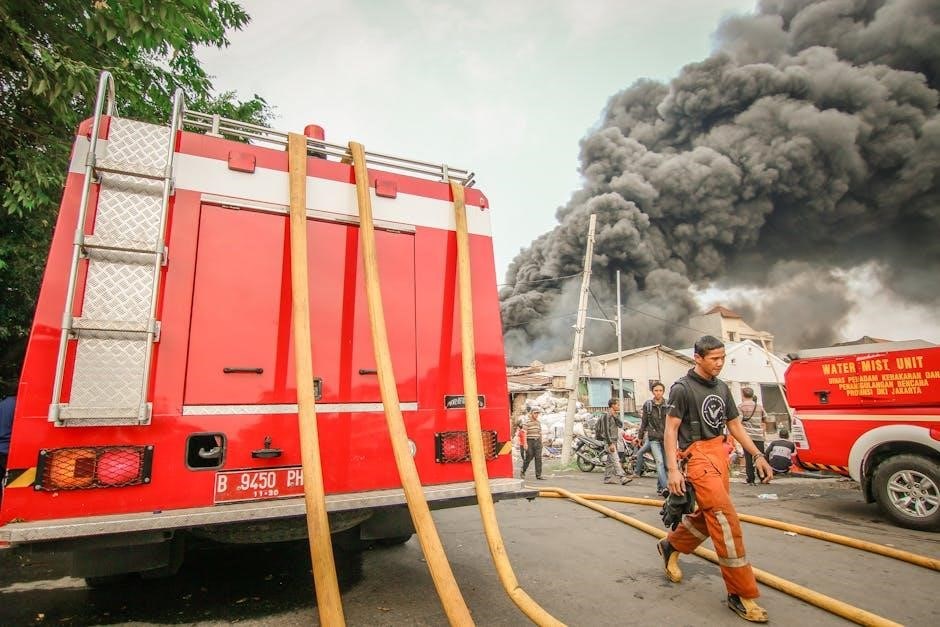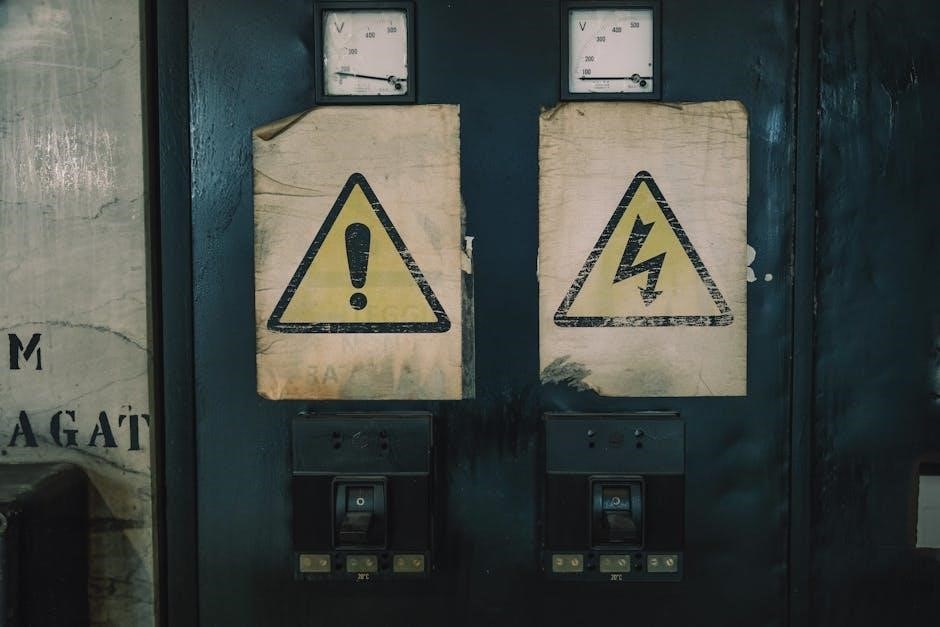First Alert CO400 Manual: A Comprehensive Guide
Welcome to your comprehensive guide for the First Alert CO400 carbon monoxide alarm! This manual provides essential information for safe operation, installation, and maintenance. We’ll help you understand key features, safety warnings, and troubleshooting tips. Let’s ensure your home’s safety together!
The First Alert CO400 is a crucial device designed to protect your family from the silent killer: carbon monoxide (CO). This battery-operated alarm utilizes an advanced electrochemical CO sensor to detect elevated CO levels in your home. CO is an odorless, colorless gas that can be deadly, making a reliable CO alarm an essential safety measure.
This alarm features an 85 dB alarm horn that sounds when CO is detected, providing an immediate alert to potential danger. It also includes a silence feature, allowing you to temporarily quiet the alarm horn in certain situations. The CO400 is designed for easy installation, offering a simple and effective way to enhance your home’s safety.
This comprehensive guide will walk you through everything you need to know about the First Alert CO400, from initial setup and proper placement to understanding alarm signals and performing routine maintenance. By following the instructions in this manual, you can ensure that your CO400 alarm provides reliable and continuous protection against the threat of carbon monoxide poisoning, giving you peace of mind and safeguarding your loved ones.
Key Features of the CO400 Carbon Monoxide Alarm
The First Alert CO400 carbon monoxide alarm boasts several key features designed to provide reliable and effective protection against CO poisoning. At its core is an advanced electrochemical sensor, which accurately detects even low levels of carbon monoxide, ensuring early warning of potential hazards. This sensor is designed for long-lasting performance, providing years of continuous monitoring.
Another essential feature is the loud 85 dB alarm horn. When CO is detected, this horn emits a distinct and attention-grabbing sound, alerting occupants to evacuate immediately. The alarm also includes a silence button, which allows you to temporarily silence the alarm during nuisance alarms, such as those caused by cooking fumes. However, it’s crucial to remember that the silence feature should only be used after verifying that there is no actual CO threat.
Furthermore, the CO400 is battery-operated, providing continuous protection even during power outages. The battery compartment is designed for easy access, making battery replacement simple and straightforward. These features combine to make the First Alert CO400 a reliable and user-friendly device for protecting your home and family from the dangers of carbon monoxide.
Safety Information and Warnings
Prioritizing safety is paramount when using the First Alert CO400 carbon monoxide alarm. This device is designed to provide an early warning of dangerous CO levels, but it is crucial to understand its limitations. The CO400 is not a substitute for proper maintenance of fuel-burning appliances, such as furnaces, water heaters, and stoves. Regular inspections by qualified technicians are essential to ensure these appliances operate safely and efficiently.
Never ignore the alarm signal! A sounding alarm indicates the presence of carbon monoxide, which can be deadly. Immediately evacuate all occupants from the premises and contact emergency services or a qualified professional to investigate the source of the CO. Do not re-enter the building until it has been thoroughly inspected and deemed safe.
It is also important to understand the symptoms of CO poisoning, which can include headache, dizziness, weakness, nausea, vomiting, chest pain, and confusion. If anyone experiences these symptoms, seek medical attention immediately. Remember, carbon monoxide is odorless and colorless, making it impossible to detect without a working alarm. Regularly test your CO400 and replace the batteries as needed to ensure continuous protection.
Installation Guide
Proper installation of your First Alert CO400 carbon monoxide alarm is crucial for optimal performance and safety. Before you begin, carefully read the entire user manual to familiarize yourself with the installation process and important safety precautions. The CO400 is designed for easy installation, but following the instructions precisely will ensure accurate detection and reliable operation.
First, select a suitable location for your alarm. It should be mounted on a wall or ceiling, ideally in or near bedrooms and living areas. Avoid placing the alarm in dusty, dirty, or greasy areas, as these conditions can affect its sensitivity. Ensure the alarm is not obstructed by furniture or curtains, which could impede airflow and delay detection.
Once you’ve chosen a location, use the included mounting bracket to secure the alarm to the wall or ceiling. For wall mounting, position the alarm approximately 5 feet from the floor. After mounting, insert the batteries according to the polarity markings inside the battery compartment. Finally, test the alarm by pressing the test button to ensure it is functioning correctly. Regular testing is essential to maintain the alarm’s effectiveness and protect your home from the dangers of carbon monoxide.
Recommended Placement of CO Alarms
Strategic placement of your First Alert CO400 carbon monoxide alarms is paramount for early detection and to safeguard your household from this silent threat. Carbon monoxide is an odorless, colorless gas, making it undetectable without a specialized alarm. Therefore, adhering to recommended placement guidelines is essential for maximum protection.
Install CO alarms on every level of your home, including the basement. Prioritize placement near sleeping areas, as occupants are most vulnerable while asleep. Position alarms within 10 feet of each bedroom door to ensure that occupants are alerted even when doors are closed. If you have multiple sleeping areas, install a CO alarm in each one.
Avoid placing alarms in areas with high humidity, such as bathrooms or laundry rooms, as moisture can damage the sensor. Do not install alarms near fuel-burning appliances, like furnaces or water heaters, as brief releases of CO during start-up are normal. Keep alarms away from windows, doors, and vents, as drafts can dilute CO and delay detection. By following these recommendations, you can optimize the effectiveness of your CO alarms and protect your family from carbon monoxide poisoning.
Operating Instructions
The First Alert CO400 carbon monoxide alarm is designed for continuous monitoring of CO levels in your home. Once installed, the alarm is always active, providing around-the-clock protection. No daily operation is typically required, but periodic testing is crucial to ensure the alarm is functioning correctly.
To test the alarm, press and hold the test button located on the alarm’s cover. The alarm should sound a loud, distinct alarm signal. If the alarm does not sound during the test, check the battery or replace the unit. It is recommended to test the alarm weekly to confirm its operational status. In the event of a CO detection, the alarm will emit a loud, pulsating alarm signal.

Familiarize yourself with the different alarm patterns, which indicate various levels of CO concentration. Never ignore an alarm signal; immediately evacuate the premises and contact emergency services or a qualified technician to investigate the source of the CO. Regularly inspect the alarm for any signs of damage or malfunction. By understanding these operating instructions, you can ensure the CO400 effectively protects you.
Understanding the Alarm Signals
The First Alert CO400 uses distinct alarm signals to communicate different situations. Recognizing these signals is crucial for responding appropriately and ensuring your safety. The primary alarm signal for carbon monoxide detection is a series of four quick beeps, followed by a pause, and then repeated. This indicates that CO has been detected and immediate action is required.

In addition to the CO alarm, the CO400 also provides signals for other events. A single chirp every minute indicates a low battery condition, signaling that the battery needs to be replaced as soon as possible. A different chirp pattern may indicate a malfunction within the alarm itself, requiring you to consult the troubleshooting section of this manual or contact customer support.
It’s important to differentiate between these signals to avoid confusion. The test button will emit a sound similar to the CO alarm, but it will stop immediately when the button is released. Familiarize yourself with these signals through regular testing and review the manual to ensure you can quickly and accurately identify the meaning of each alarm sound.
Silence Feature Functionality
The First Alert CO400 includes a silence feature designed to temporarily quiet the alarm during nuisance situations. This feature is particularly useful when you suspect a false alarm, such as from cooking fumes or other non-hazardous sources. When the alarm sounds, pressing the test/silence button will silence the alarm for a period of approximately four to ten minutes.
It is crucial to understand that the silence feature only temporarily silences the alarm. If the CO levels remain high or continue to rise during the silence period, the alarm will reactivate. This ensures that you are still alerted to potentially dangerous CO levels, even if you initially suspected a false alarm. Never ignore a reactivated alarm; investigate the source of the CO immediately.
Using the silence feature does not disable the alarm permanently, and it should never be used as a substitute for addressing the underlying cause of a CO leak. After silencing the alarm, ventilate the area and investigate potential sources of carbon monoxide. If the alarm continues to sound, evacuate the premises and contact emergency services or a qualified technician. The silence feature is a temporary convenience, not a solution.
Battery Information and Replacement
The First Alert CO400 carbon monoxide alarm operates using batteries to ensure continuous protection, even during power outages. It is crucial to use the correct type of batteries as specified by the manufacturer. Typically, this alarm requires two AA batteries. Refer to the product manual for the exact battery specifications to maintain optimal performance and prevent damage to the device.
When the batteries are low, the CO400 will emit a chirping sound, indicating that the batteries need to be replaced. Replace the batteries immediately upon hearing this warning signal to ensure uninterrupted CO detection. To replace the batteries, first, turn off the device. Then, open the battery compartment, usually located on the back or side of the alarm. Remove the old batteries and insert new ones, ensuring they are correctly aligned according to the polarity markings inside the compartment.
After replacing the batteries, test the alarm by pressing the test button. A loud beep confirms that the alarm is functioning correctly. It’s a good practice to replace the batteries every six months or annually, even if the low battery warning hasn’t sounded, to maintain reliable protection. Always dispose of used batteries responsibly according to local regulations.

Maintenance and Cleaning
Proper maintenance and regular cleaning are essential for ensuring the First Alert CO400 carbon monoxide alarm functions effectively and reliably over its lifespan. Dust and debris accumulation can impede the sensor’s ability to accurately detect carbon monoxide levels, potentially compromising your safety. To maintain optimal performance, clean the CO400 alarm at least once a month.
Before cleaning, always turn off the alarm to prevent any accidental activation or damage. Use a soft brush or a vacuum cleaner with a brush attachment to gently remove dust and debris from the exterior surfaces of the alarm. Pay particular attention to the sensor vents, ensuring they are free from obstructions. Avoid using water, cleaning solutions, or solvents, as these can damage the sensor or other internal components.
After cleaning, inspect the alarm for any signs of damage or wear. Check the battery compartment for corrosion or leaks. If you notice any issues, replace the batteries or contact customer support for assistance. Regularly test the alarm after cleaning by pressing the test button to confirm it is functioning correctly. Consistent maintenance will help extend the life of your CO400 alarm and ensure it provides accurate and timely warnings.

Troubleshooting Common Issues
Encountering issues with your First Alert CO400? This section addresses common problems and their solutions. If your alarm chirps intermittently, it usually indicates low batteries. Replace them immediately with fresh ones, ensuring correct polarity. If the chirping persists after battery replacement, the alarm may be malfunctioning and require replacement.
False alarms can occur due to temporary exposure to high levels of CO from sources like vehicles or appliances. Ensure proper ventilation and check for any potential sources. If the alarm sounds continuously despite no apparent CO source, ventilate the area and contact emergency services. A malfunctioning sensor can also trigger false alarms; consider replacing the alarm if this persists.
If the alarm fails to sound during a test, verify the batteries are correctly installed and have sufficient charge. If the problem persists, the alarm may be defective and needs replacement. Regularly test your alarm to ensure it’s functioning correctly. For persistent issues, consult the First Alert customer support or refer to the complete manual for further troubleshooting steps and solutions.
Warranty Information
Your First Alert CO400 carbon monoxide alarm comes with a limited warranty, safeguarding against defects in materials and workmanship under normal use and service. This warranty typically extends for a period of five years from the date of purchase. During this period, First Alert will repair or replace, at its option, any defective alarm that is returned, postage prepaid, with proof of purchase.
This warranty does not cover damage resulting from accident, misuse, abuse, neglect, improper installation, or unauthorized modification. It also excludes damage caused by battery leakage or failure to follow the instructions outlined in the user manual. To make a warranty claim, contact First Alert customer support to obtain a Return Merchandise Authorization (RMA) number and shipping instructions.
The warranty provides specific legal rights, and you may also have other rights that vary from state to state. It is essential to retain your proof of purchase for warranty validation. For complete details and any limitations, please refer to the full warranty statement included with your alarm or available on the First Alert website. Ensure you understand the terms and conditions to benefit fully from the coverage provided.
Where to Find the Complete Manual
Accessing the complete manual for your First Alert CO400 carbon monoxide alarm is simple and convenient. The primary location to find the full manual is the official First Alert website. Navigate to the “Support” or “Downloads” section and search for your specific model, CO400. There, you will find a downloadable PDF version of the manual, which you can save to your computer or print for easy reference.
Alternatively, you may find a physical copy of the manual included in the product packaging when you initially purchased the CO400 alarm. Check inside the box and among the included documents. If you’ve misplaced the physical copy, the online version is readily available.
Another resource is the retailer where you bought the alarm. Many retailers, especially those with online presence, often provide links to product manuals on the product page. Furthermore, online search engines can quickly direct you to the First Alert website or other reliable sources hosting the manual. Always ensure that you are downloading the manual from a trusted website to avoid potential security risks. Having the complete manual ensures you have all necessary information at your fingertips.